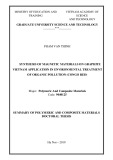
3
widely used.
In 1991, Y. Kuga and colleagues studied a method of crushing graphite
compounds alternating with potassium K-GIC and exfoliating graphite K-
EG in a vacuum. In 1991, Yoshida and colleagues also successfully
researched in the production of various insertion compounds such as
insertion with H2SO4, FeCl3, Na-tetrahydrofuran (THF), K-THF and Co-
THF. The interleaved compounds were then rapidly heated to 1000 0C to
expand the graphite.
In summary, through the analysis of the research results of the authors
who came before the thesis, we will choose the method of synthesizing EG
materials by chemical methods with the insertion agent of H2SO4 and H2O2
under the support of microwaves. Civil, in order to combine the good criteria
such as simple method, low cost, and high adsorption efficiency. At the
same time under the microwave support to shorten the synthesis time as well
as improve the efflux efficiency of graphite.
1.3. Magnetic materials
1.3.1. Synthesis of EG@MFe2O4 materials
Cobalt ferrite, nickel ferrite, and manganese ferrite are very important
spinel ferrite in engineering. Structurally, cobalt ferrite and nickel ferrite
crystals are typical of spinel ferrite group, face centered cubic structure.
They are the reverse spine, Because the electron configuration of Ni2+ ions
is 3d8, of Co2+ ion, is 3d7, the favorable coordination number is 6, so Ni2+
and Co2+ ions are in octahedral holes and Fe3+ ions are distributed in both
octahedral and tetrahedral holes.
There are two approaches to synthesizing spine ferritic material: the
approach from the top and the bottom. The top-down approach uses physical
methods, while the bottom-up approach is usually done by chemical
pathways. Methods of synthesis by chemical colloid can control the particle
size, the collected nanoparticles have uniform size, rich shape. Typical
chemical methods commonly used include precipitation, reduction,
explosion, thermal decomposition hot spray, micelles (reverse), sol-gel
process, flocculation directly in high boiling solvents, hydro heat. The






















